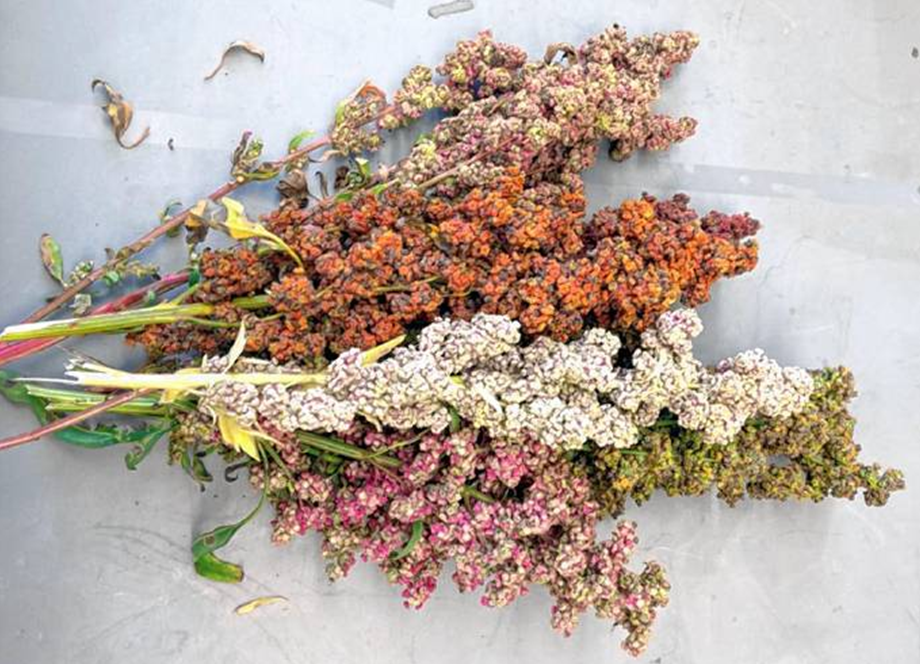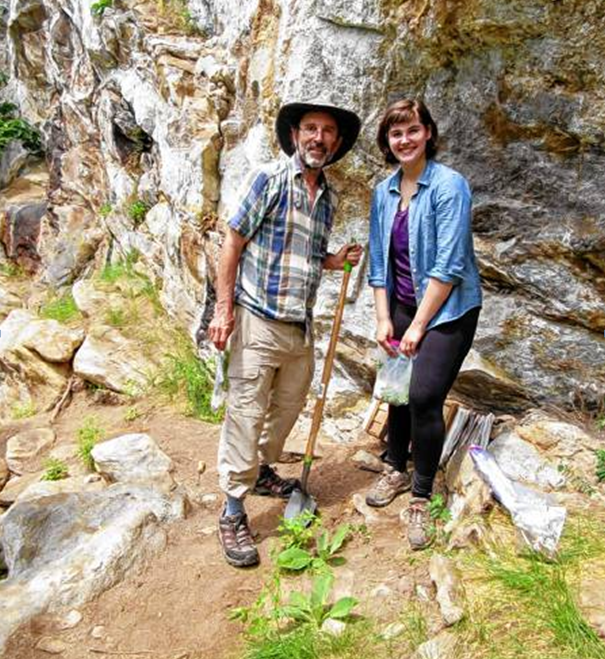
Multicolored quinoa seed heads grown at the UNH Woodman Horticultural Research Farm, 2017. —UNH

Dr. Tom Davis and graduate student Erin Neff at a wild chenopod study site. 2017 —UNH

Study plantation of quinoa, lambsquarters, and other weedy chenopods at the UNH Woodman Horticultural Research Farm. 2017 —UNH
This is a story about UNH researchers’ attempts to use traditional plant breeding, boosted by knowledge about genetics, to create a version of quinoa that can be raised in New Hampshire.
It’s interesting stuff, but first let’s get over the whole “quinoa” thing, shall we?
Yes, the superfood qualities of quinoa have been exaggerated. Yes, it has a weird name (pronounced “keen-wha,” I think). And yes, it is annoyingly trendy, drenched in a self-righteous hipster vibe that can set your teeth on edge.
But quinoa truly is a nutritious and tasty grain, and it does add needed variety to the bordering-on-monoculture habits of modern cuisine. It would be useful and profitable if we could grow it here, creating something truly new for New England’s local food movement.
All of this explains why Tom Davis and graduate students have been stomping around in the region’s sandy and highly-stressed environments searching for weeds of the Chenopodium family, a quinoa relative, that could be crossed with quinoa. They hope such cross-breeding can eventually create a quinoa variety that we could grow here, changing a plant that thrives in the Andes Mountains into one that thrives in the Granite State.
This isn’t a novel idea. Cross-breeding plants with related species to increase desirable traits has been part of plant domestication for thousands of years.
“It’s important to recognize that every crop plant has wild relatives. For most cultivated plants, domestication has changed them a little bit or a lot over many generations,” said Davis, professor of biology and genetics at UNH. “We want to reach back into the gene pool ... and ability to do that depends on whether you can make a successful cross between crop plant and wild relatives.”
Davis said he thinks this is possible with quinoa because it has happened before.
“When we first started looking into this, we found that there was an independent domestication of something like quinoa that took place in the southeastern U.S. maybe a thousand years ago. The Native Americas were cultivating this wild relative that is distributed quite widely and were making some progress on domesticating it. So it seems to be a plant that is immutable to being re-domesticated,” he said.
Why don’t we hear about that early quinoa domestication? Corn, or maize, arrived from Mexico and out-competed the native plant into extinction.
This is roughly what has happened in the modern world. Corn and a few other grains such as rice and wheat have driven everything else out of our shops and kitchens. Part of the push for food security involves developed alternative crops in case some disease wipes out one of the big crops.
The work is happening through the New Hampshire Agricultural Experiment Station at UNH in Durham at the UNH Woodman Horticultural Research Farm.
Note that Davis’s team and collaborators at universities in Maine and Vermont are not seeking to directly tweak quinoa’s genes to create a local variety – they are going to use traditional cross-breeding, not genetically modified organisms.
But they are using GMO techniques to help guide this cross-breeding, taking advantage of so-called marker genes that are associated with various traits in the plant, such as resistance to fungal diseases or better seed production.
(An aside for biology geeks: Finding marker genes in quinoa is hard because it is tetraploid, meaning it has roughly twice the usual number of chromosomes. That’s one of the obstacles this research will have to overcome.)
Once researchers start doing cross-breeding, if they spot marker genes they’ll know the resulting plant will have the associated trait, without having to spend a season growing and testing plants to find out.
“We think that it may be possible to accelerate the domestication or breeding process this way. It takes hundreds or thousands of generations for plants to become domesticated in the normal way, but we think we can speed that up substantially without having to go to genetic manipulation,” Davis said.
That’s a bigger idea lurking within this project: To test and develop procedures that can speed up cross-breeding for any crop.
“We don’t simply want to breed locally adapted quinoa. We want to see if there’s potential to take a native plant and push it through an accelerated evolutionary process and push it to new state ... that can be grown here,” Davis said.
This might even make up for an agricultural shortfall in New Hampshire history. None of our native plants were ever cross-bred into a form usable by people.
“Lots of plants here in New Hampshire had the potential to be domesticated, but the circumstances just weren’t right for it,” Davis said.
Maybe the circumstances are right now. Imagine going to your local farmers market and seeing locally grown spelt or buckwheat or oats alongside the zucchini and blueberries.
That would be pretty cool – even if you’re not a hipster.
(David Brooks can be reached at 369-3313 or dbrooks@cmonitor.com or on Twitter.)


















